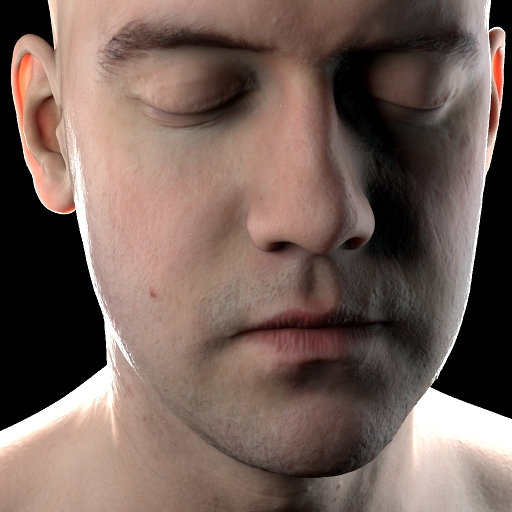
 |
 |
Photon Beam Diffusion: A Hybrid Monte Carlo Method for Subsurface Scattering Ralf Habel, Per H. Christensen, Wojciech Jarosz June 2013 We present photon beam diffusion, an efficient numerical method for accurately rendering translucent materials. Our approach interprets incident light as a continuous beam of photons inside the material. Numerically integrating diffusion from such extended sources has long been assumed computationally prohibitive, leading to the ubiquitous single-depth dipole approximation and the recent analytic sum-of-Gaussians approach employed ... [more] Additional materials: [PBD_matlab_v1.03.zip], [supplemental-theory.pdf] Published in Computer Graphics Forum (Proceedings of the Eurographics Symposium on Rendering 2013), volume 32, number 4. Eurographics / Blackwell Publishers, June 2013. (Zaragoza, Spain, June 19-21.). Equation 13 amended July 2013. |
 |
Multiresolution Radiosity Caching for Efficient Preview and Final Quality Global Illumination in Movies Per H. Christensen, George Harker, Jonathan Shade, Brenden Schubert, Dana Batali July 2012 We present a multiresolution radiosity caching method that allows global illumination to be computed efficiently in a single pass in complex CG movie production scenes.
For distribution ray tracing in production scenes, the bottleneck is
the time spent evaluating complex shaders at the ray hit points. We
speed up this shader ... [more] |
 |
Point-Based Global Illumination for Movie Production Per H. Christensen July 2010 This course note describes a fast point-based method for computing diffuse and glossy global illumination, area light illumination and soft shadows, HDRI environment map illumination, multiple diffuse reflection bounces, final gathering for photon mapping, ambient occlusion, reflection occlusion, and volume scattering. The results are free of noise and the ... [more] Additional materials: [Slides.pdf] |
 |
Point-Based Approximate Color Bleeding Per H. Christensen July 2008 This technical memo describes a fast point-based method for computing diffuse global illumination (color bleeding). The computation is 4-10 times faster than ray tracing, uses less memory, has no noise, and its run-time does not increase due to displacement-mapped surfaces, complex shaders, or many complex light sources. These properties make the method suitable ... [more] Additional materials: [SlidesFromAnnecy09.pdf] Available as Pixar Technical Memo #08-01 |
 |
High-Quality Rendering Using Ray Tracing and Photon Mapping Henrik Wann Jensen, Per H. Christensen August 2007 Detailed descriptions of the ray-tracing and photon-mapping algorithms for rendering complex scenes with indirect illumination, caustics, participating media, and subsurface scattering. The emphasis is on the practical insight necessary to use and implement these algorithms in production of high-quality image in movies, games, architecture, etc. Available as Siggraph 2007 course notes, Course Number 8 |
 |
Ray Tracing for the Movie 'Cars' Per H. Christensen, Julian Fong, David M. Laur, Dana Batali September 2006 This paper describes how we extended Pixar's RenderMan renderer with ray tracing abilities. In order to ray trace highly complex scenes we use multiresolution geometry and texture caches, and use ray differentials to determine the appropriate resolution. With this method we are able to efficiently ray trace scenes with much more geometry and ... [more] Available in Proceedings of the IEEE Symposium on Interactive Ray Tracing 2006, pages 1-6. IEEE 2006 |
 |
An Irradiance Atlas for Global Illumination in Complex Production Scenes Per H. Christensen, Dana Batali June 2004 We introduce a tiled 3D MIP map representation of global illumination data. The representation is an adaptive sparse octree with a "brick" at each octree node; each brick consists of 8 cubed voxels with sparse irradiance values. The representation is designed to enable efficient caching. Combined with ... [more] Published as pp. 133-141 in the Proceedings of the Eurographics Symposium on Rendering 2004, Eurographics/ACM, June 2004. |
 |
Ray Differentials and Multiresolution Geometry Caching for Distribution Ray
Tracing in Complex Scenes Per H. Christensen, David M. Laur, Julian Fong, Wayne L. Wooten, Dana Batali September 2003 When rendering only directly visible objects, ray tracing a few levels of specular reflection from large, low curvatures surfaces, and ray tracing shadows from point-like light sources, the accessed geometry is coherent and a geometry cache performs well. But in many other cases, ... [more] Published as pp. pp. 543-552 in Computer Graphics Forum (Eurographics 2003 Conference Proceedings), Blackwell Publishers, September 2003. |
 |
Adjoints and Importance in Rendering: an Overview Per H. Christensen July 2003 This survey gives an overview of the use of importance, an adjoint of light, in speeding up rendering. The importance of a light distribution indicates its contribution to the region of most interest --- typically the directly visible parts of a scene. Importance can therefore be used to concentrate global illumination and ray ... [more] Available as IEEE Transactions on Visualization and Computer Graphics (TVCG), Volume 9, Number 3, pages 329-340. IEEE, July 2003. |
 |
RenderMan, Theory and Practice Dana Batali, Byron Bashforth, Chris Bernardi, Per H. Christensen, David M. Laur, Christophe Hery, Guido Quaroni, Erin Tomson, Thomas Jordan, Wayne L. Wooten July 2003 Siggraph 2003 course notes. |